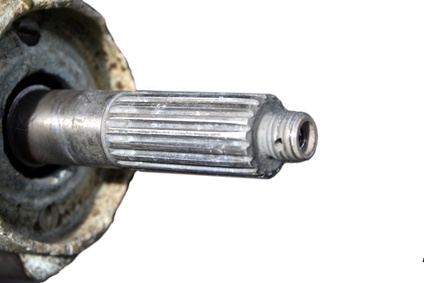
The drive shaft, sometimes called the impeller shaft, has the job of transferring engine power to the rear wheels. In the case of four-wheel-drive vehicles, shorter drive shafts transfer energy to individual wheels, while the front-wheel trans-axle has one drive shaft for each wheel. The drive shaft has components that allow it to couple with the differential housing (rear end) at any angle by using joints that allow flex and off-angle positioning when the suspension moves up and down. Understanding the drive shaft parts can help you anticipate problems during routine inspections and driving.
The drive shaft consists of a long hollow tube made from high-strength steel. Its long length requires it to bridge the gap between the transmission end shaft and the differential housing (rear end). The drive shaft transfers direct torque energy from front to rear. The drive shaft's hollow design cuts down on weight, which reduces rotational drag. The stress loads on drive shafts can be tremendous, but their hollow design that incorporates an inside and outside surface structure resists the most powerful stresses and shock loads.

Every drive shaft has metal weights welded onto the tube housing at strategic locations. The weights resemble match books in size and thickness. For the drive shaft to spin true in perfect balance, weights must be added or subtracted to it. A machine shop normally provides this service. Without weight balancing, the drive shaft would radically shudder or vibrate, which if prolonged, could snap or bend the drive shaft tube.
The typical rear-wheel drive shaft has four connecting yokes--two at the front end of the drive shaft tube and two at the rear. Three of the yokes have a U-shaped design that allows them to connect to universal joint bearing caps. The heavier front-end yoke comes designed with a short, inside-spline shaft that fits into the transmission input shaft. The furthest yoke on the end of the drive shaft connects to the differential housing, and it has two C-shaped mounting straps and retainer nuts.
Universal joints have an X-shaped design that allows them to couple the drive shaft with the transmission and differential housing. Four bearing caps sit on each end of the universal joint. The caps hold precision needle bearings inside that rotate with the drive shaft. The universal joint allows the off-angle positioning of the drive shaft that moves up and down with the suspension. The bearing caps press directly into the yoke ends. Many drive shafts have factory-sealed universal joints--the bearings do not have to be lubricated for life.
Some of the older drive shafts came with "zerk" (grease nipples) fittings screwed into the universal joint body. These type of universal joints have to be manually lubricated with a grease gun at certain maintenance intervals. Car enthusiasts often desire the old style universal joints because lubrication was assured instead of waiting for the symptoms of a dry universal joint that can sometimes crack or break loose suddenly without warning.